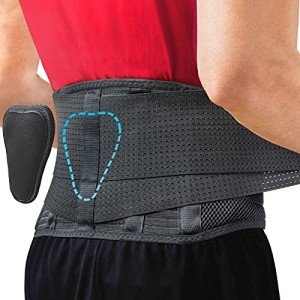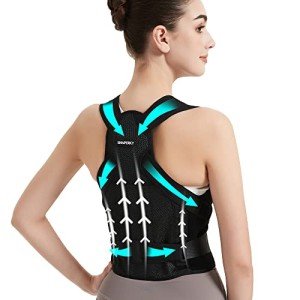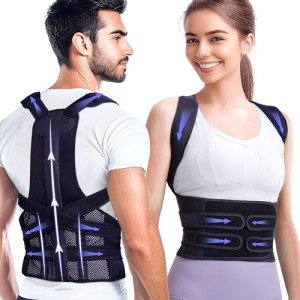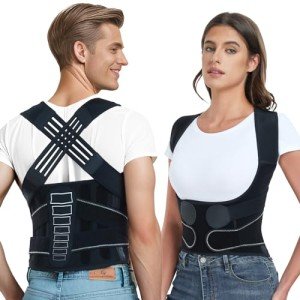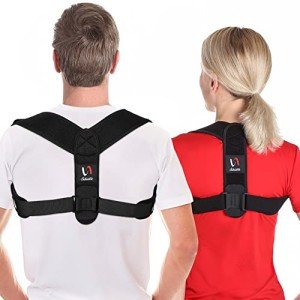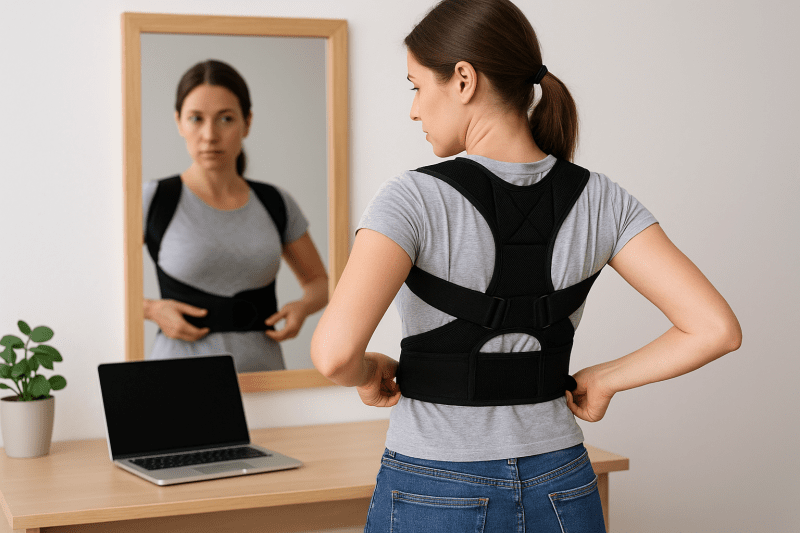If you’ve been researching ways to improve your posture, you’ve probably come across both back braces and posture correctors. At first glance, they sound like the same thing — but they’re actually designed for different purposes.
So which one is right for you? Let’s look at the key differences between a back brace vs posture corrector, how each works, and how to decide which one fits your needs best.
What Is a Back Brace?
A back brace is a supportive device that helps stabilize the spine and reduce strain on your back muscles. It’s often used by people recovering from injuries, managing chronic pain, or needing extra support during daily activities.
Back braces come in many forms — from flexible neoprene designs for mild support to more structured versions used in medical settings.
They’re great for:
-
Lower back pain relief
-
Spinal alignment support
-
Lifting or physical work
-
Post-surgery recovery
The goal of a back brace is to limit excessive movement, reduce pressure on the spine, and help you maintain proper alignment.
Sparthos Back Brace for Lower Back Support
Experience everyday comfort and relief with this supportive back brace designed to help you stay active and pain-free
Product information
$29.97
Product Review Score
4.76 out of 5 stars
180 reviewsProduct links
What Is a Posture Corrector?
A posture corrector focuses on the upper body — mainly your shoulders and upper back. It’s a lightweight harness or band that gently pulls your shoulders back, encouraging your spine to align naturally.
While a back brace provides firm support, a posture corrector acts more like a reminder. It helps retrain your muscles to stay upright, even after you take it off.
They’re ideal for:
-
Reducing slouching and rounded shoulders
-
Improving posture awareness
-
Office or desk workers
-
Preventing muscle fatigue from sitting too long
Think of a posture corrector as a training tool for your body — it doesn’t hold you rigid, but it helps your muscles learn what “good posture” feels like.
Posture Corrector Brace for Women and Men
Achieve better posture and confidence with our comfortable and adjustable posture corrector brace designed for everyone
Product information
$38.99 $30.99
Product Review Score
4.7 out of 5 stars
118 reviewsProduct links
Back Brace vs Posture Corrector: The Main Differences
| Feature | Back Brace | Posture Corrector |
|---|---|---|
| Main Focus | Lower back and spine | Upper back and shoulders |
| Support Level | Firm, stabilizing support | Light, corrective feedback |
| Purpose | Pain relief, recovery, heavy lifting | Posture training, slouch prevention |
| Wear Time | Short-term for support | Short sessions for habit building |
| Best For | People with back pain or injuries | People with poor posture or desk fatigue |
Both tools serve different purposes, and choosing between them depends on your goals.
When to Choose a Back Brace
You might benefit more from a back brace if you:
-
Experience lower back pain or strain
-
Do physical labor, lifting, or long periods of standing
-
Are recovering from an injury or surgery (with medical guidance)
-
Need extra spinal support throughout the day
Back braces are designed for support and pain relief. If your issue is more about back fatigue or discomfort than slouching, a back brace may be the right fit.
When to Choose a Posture Corrector
A posture corrector might be better if you:
-
Sit at a computer or desk for hours
-
Catch yourself slouching or hunching your shoulders
-
Want to improve your posture awareness and alignment
-
Don’t have chronic back pain, just bad posture habits
Posture correctors are perfect for building awareness and breaking the “tech neck” cycle that comes from constant screen time.
Can You Use Both?
Yes! Many people actually benefit from using both at different times.
For example, you might use a posture corrector while working at your desk to train better alignment and switch to a back brace during physical tasks that require more support.
Just remember: both tools work best when paired with stretching, strengthening exercises, and an ergonomic setup.
How to Use Them Safely
No matter which option you choose, a few safety tips will help you get the best results:
-
Don’t wear it all day — 1–3 hours a day is enough.
-
Make sure it fits comfortably (snug but not tight).
-
Combine it with movement and core exercises.
-
Take breaks and stretch regularly.
Wearing a brace should support your muscles, not replace their function.
The Bottom Line
When comparing a back brace vs posture corrector, it really comes down to your goal:
-
Choose a back brace if you need firm support and relief from lower back pain.
-
Choose a posture corrector if your main goal is to improve posture habits and reduce slouching.
Used correctly, both can help you build a healthier spine, stronger muscles, and better body awareness.
For more help choosing the right option, check out our full guide:
👉 Best Back Brace to Help with Posture: What Works, When to Use It, and Safety Tips

